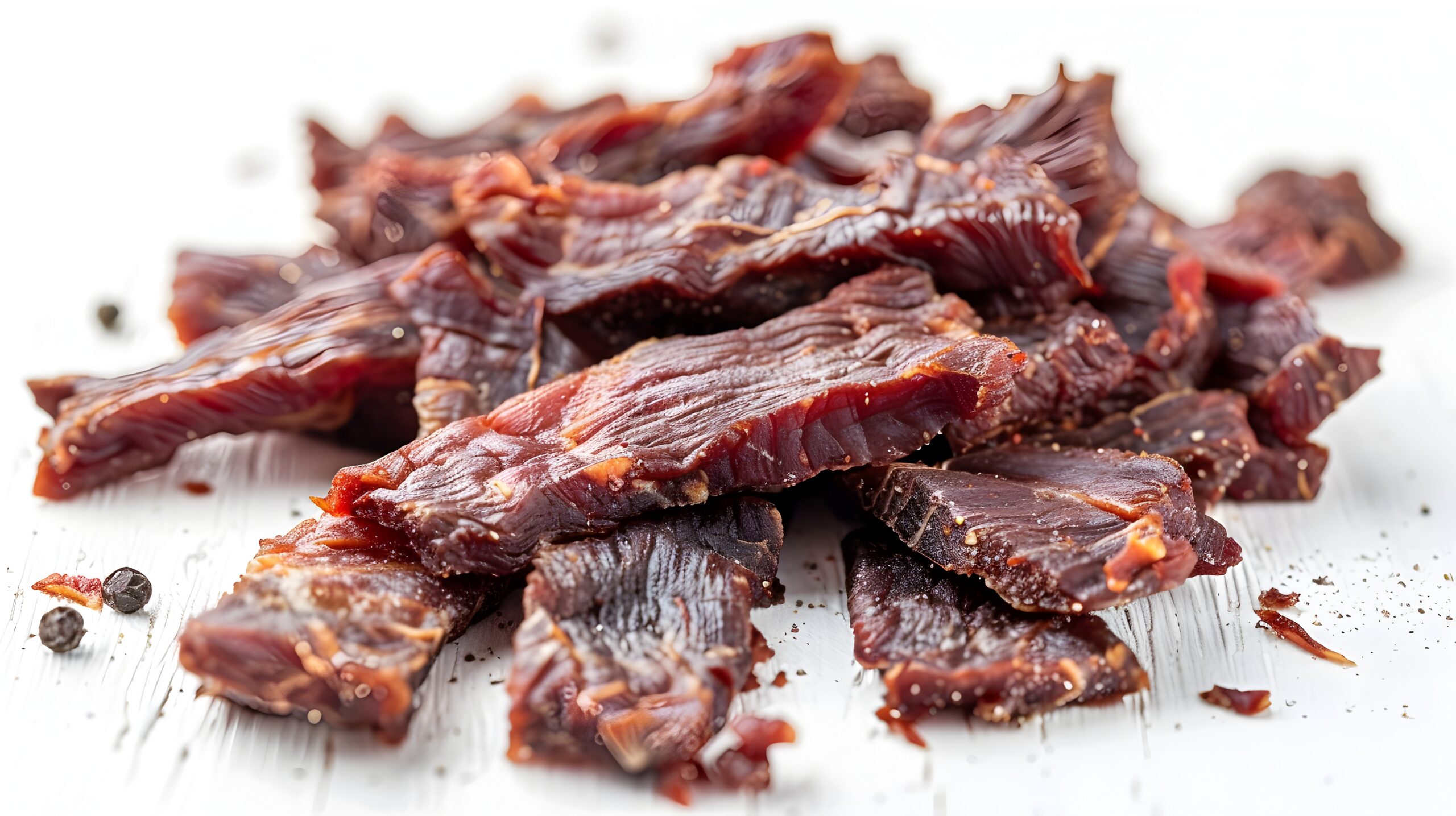Beef jerky is a beloved snack that has been enjoyed for centuries, not just for its savory taste, but also for its convenience and nutritional value. Whether you’re a seasoned pro or a beginner looking to make your first batch, this comprehensive guide will walk you through everything you need to know about making beef jerky at home. From selecting the right cut of beef to mastering the drying process, we’ve got you covered.
Introduction to Beef Jerky
Beef jerky is a type of dried meat snack made by curing strips of beef with salt and other seasonings, then drying them until they become chewy and flavorful. This preservation method not only extends the shelf life of the meat but also intensifies its flavor, making it a satisfying and portable snack.
The popularity of beef jerky has grown significantly over the years, thanks to its high-protein content and low-carb profile. It’s an ideal snack for those on-the-go, and it’s especially favored by athletes and outdoor enthusiasts who need a nutrient-dense option that doesn’t require refrigeration. For those interested in the health benefits of high-protein snacks, you can explore more about the health benefits of high-protein snacks and how they fit into a balanced diet.
The History of Beef Jerky
Beef jerky has a rich history that dates back to ancient times when indigenous peoples used it as a way to preserve meat for long journeys. The practice of drying meat has been used by various cultures around the world, each with their own unique methods and seasonings.
Over time, the process of making beef jerky evolved, with different flavors and techniques being introduced. Today, beef jerky is not just a survival food but a gourmet snack enjoyed by many. If you’re interested in the origins of this popular snack, take a look at the history of beef jerky to see how it has evolved from its humble beginnings to the modern variations we enjoy today.
Essential Ingredients for Beef Jerky
The key to great beef jerky lies in the ingredients you choose. Here’s a breakdown of the essential components:
Beef Cuts
- Top Round: One of the most popular cuts for jerky due to its leanness and affordability.
- Bottom Round: Another lean cut, slightly more tender than the top round.
- Sirloin Tip: A more tender option, though slightly more expensive.
- Brisket: For a richer, fattier flavor, though it requires more careful drying to avoid spoilage.
For a deeper understanding of which cuts work best, refer to this guide on the best beef cuts for jerky or explore other delicious beef recipes.
Seasonings and Marinades
- Salt: Essential for curing the meat and adding flavor.
- Sugar: Common in many recipes, it helps balance the salt and adds a caramelized flavor.
- Soy Sauce: Adds umami and saltiness to the jerky.
- Worcestershire Sauce: A classic ingredient that adds depth and a tangy flavor.
- Garlic and Onion Powder: Staples for seasoning beef jerky.
- Black Pepper: For a bit of heat and complexity.
Alternative Ingredients
- Honey or Maple Syrup: For a sweet twist on traditional jerky.
- Cayenne Pepper: For those who like it spicy.
- Liquid Smoke: Adds a smoky flavor without needing a smoker.
Equipment Needed for Making Beef Jerky
While beef jerky can be made with basic kitchen tools, having the right equipment can make the process easier and yield better results.
Traditional vs. Modern Methods
- Air Drying: The most traditional method, though it requires a dry, warm climate.
- Sun Drying: Similar to air drying, but using the sun’s heat—ideal for very dry environments.
Modern Equipment
- Dehydrator: The most reliable and easiest method for making consistent beef jerky. Dehydrators control temperature and airflow, ensuring even drying.
- Oven: A common household alternative to a dehydrator. Set the oven to its lowest temperature and prop the door open slightly to allow moisture to escape.
- Smoker: For those who love a deep, smoky flavor, a smoker is a great option. The low, slow heat of a smoker also helps to cure the meat as it dries. If you’re into smoking meats, consider how you can perfect your smoking techniques with different recipes.
When choosing the best equipment for your needs, it’s important to consider how each method impacts the flavor and texture of your jerky. Learn more about dehydrating meat safely to ensure your homemade jerky is not only delicious but also safe to eat.
Step-by-Step Guide to Making Beef Jerky
Making beef jerky at home is a straightforward process, but it requires patience and attention to detail. Here’s a step-by-step guide to help you create the perfect batch:
Preparation of the Meat
- Select Your Cut: Choose a lean cut of beef such as top round, bottom round, or sirloin tip.
- Trim the Fat: Remove any visible fat to prevent spoilage during drying.
- Slice the Meat: For chewy jerky, slice the meat with the grain; for a more tender jerky, slice against the grain. Aim for slices that are about 1/8 to 1/4 inch thick.
Marinating the Meat
- Prepare the Marinade: Combine soy sauce, Worcestershire sauce, garlic powder, onion powder, black pepper, and any other desired seasonings.
- Marinate the Meat: Place the sliced beef in the marinade, ensuring each piece is fully coated. Cover and refrigerate for at least 4 hours, but ideally overnight.
Drying the Meat
- Set Up Your Equipment: Preheat your dehydrator to 160°F, or set your oven to its lowest temperature.
- Arrange the Meat: Lay the marinated beef slices in a single layer on the dehydrator trays or on a wire rack over a baking sheet in the oven.
- Drying Time: Dehydrate for 4-6 hours, checking the jerky regularly. The jerky is done when it bends and cracks but doesn’t break.
- Testing Doneness: To test, remove a piece of jerky and let it cool slightly. Bend it—if it cracks slightly but doesn’t snap in half, it’s ready.
Storing the Jerky
- Cool the Jerky: Allow the jerky to cool completely before storing.
- Storage Options: Store in an airtight container or vacuum-sealed bag. Properly dried and stored jerky can last for several weeks at room temperature or several months in the refrigerator.
Popular Beef Jerky Recipes
Once you’ve mastered the basics, it’s time to experiment with different flavors. Here are some popular beef jerky recipes to get you started:
Classic Beef Jerky
- Ingredients: Soy sauce, Worcestershire sauce, black pepper, garlic powder, onion powder, and liquid smoke.
- Flavor Profile: This recipe is all about the balance of salty, savory, and smoky flavors.
- Instructions: Marinate the beef in the mixture overnight and then dry using your preferred method.
Spicy Beef Jerky
- Ingredients: Soy sauce, Worcestershire sauce, cayenne pepper, crushed red pepper flakes, and black pepper.
- Flavor Profile: For those who like it hot, this recipe packs a punch with layers of heat.
- Instructions: Marinate the beef, ensuring it’s well-coated with the spices, and dry as usual.
Sweet and Savory Jerky
- Ingredients: Soy sauce, brown sugar, honey or maple syrup, black pepper, and garlic powder.
- Flavor Profile: The sweetness of honey or maple syrup contrasts beautifully with the savory seasonings.
- Instructions: Marinate and dry as usual, being careful not to over-dry to maintain some of the sweet, chewy texture.
Common Mistakes to Avoid
Even with a great recipe, there are a few common pitfalls to watch out for when making beef jerky at home:
Over-Drying or Under-Drying
- Over-drying can result in tough, brittle jerky, while under-drying can leave moisture in the meat, increasing the risk of spoilage. Always monitor the drying process closely and use the bend test to determine doneness.
Using the Wrong Cut of Meat
- Selecting a fatty cut of meat can result in greasy jerky that doesn’t store well. Stick to lean cuts like top round or sirloin tip, and always trim any visible fat.
Not Marinating Long Enough
- The marinade is essential for infusing flavor into the meat. Rushing this process can result in bland jerky. For best results, marinate the meat for at least 12 hours, or overnight.
Improper Storage Leading to Spoilage
- Beef jerky must be stored properly to prevent spoilage. After drying, allow the jerky to cool completely before sealing it in an airtight container or vacuum-sealed bag.
Health Benefits and Nutritional Information
Beef jerky is more than just a tasty snack—it’s also packed with nutrition. Here’s why it can be a healthy addition to your diet:
High Protein Content
- Beef jerky is a high-protein snack, making it an excellent choice for those looking to increase their protein intake. A typical serving of beef jerky can provide anywhere from 9 to 14 grams of protein, depending on the brand and recipe.
Low in Carbs
- Because it’s made from lean meat, beef jerky is naturally low in carbohydrates, making it suitable for low-carb and keto diets. Just be mindful of added sugars in some flavored varieties.
Sodium Content
- One thing to watch out for with beef jerky is the sodium content, which can be high due to the curing process. However, you can control this by making your own jerky at home and adjusting the salt content to your preference.
Healthier Alternatives
- To make a healthier version, opt for lean cuts of beef, reduce the amount of salt in your marinade, and avoid adding too much sugar. You can also experiment with natural flavorings like herbs and spices to keep it tasty without the extra sodium.
Frequently Asked Questions
How long does homemade beef jerky last?
Homemade beef jerky can last for 1-2 months if stored in an airtight container at room temperature. For longer storage, consider vacuum sealing and refrigerating or freezing the jerky.
Can I make beef jerky without a dehydrator?
Yes, beef jerky can be made using an oven or smoker. The key is to maintain a low temperature and proper airflow to dry the meat evenly.
What is the best cut of meat for beef jerky?
The best cuts of meat for beef jerky are lean cuts like top round, bottom round, or sirloin tip. These cuts are less likely to spoil and have the right texture for jerky.
How can I make my beef jerky less salty?
To reduce the saltiness, lower the amount of soy sauce or salt in your marinade. You can also rinse the beef slices in water before drying to remove excess salt.
Is beef jerky healthy?
Beef jerky is a healthy snack option, particularly if made at home where you can control the ingredients. It’s high in protein and low in carbs, making it suitable for various diets, but watch out for sodium content.
Conclusion
Beef jerky is a versatile and delicious snack that you can easily make at home with the right ingredients and techniques. Whether you prefer it spicy, sweet, or classic, homemade jerky offers endless possibilities for customization. By following the steps outlined in this guide, you’ll be well on your way to creating your own batch of flavorful, chewy jerky.
Don’t hesitate to experiment with different marinades and drying methods to find your perfect recipe. And remember, the key to great jerky is patience—let the meat marinate, dry it slowly, and enjoy the satisfying reward of homemade beef jerky.
If you’re looking for more recipes to complement your jerky, why not check out some delicious dips and sides to complete your snack spread?

